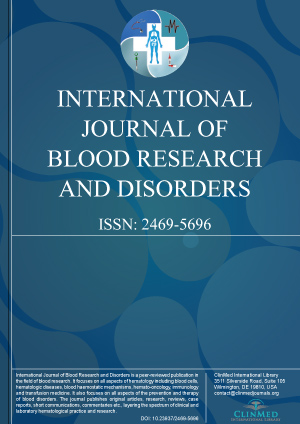Open Access DOI:10.23937/2469-5696/1410094
C-mip Involvement as a Thrombosis Risk Factor in Children with Idiopathic Nephrotic Syndrome in Abidjan, Côte D'Ivoire
N'Draman-Donou AE, Yapo AVDP, Koumi-Mélèdje MD, Adjambri AE, N'Guessan-Blao AR, Ehilé-Kacou AM, Bouah-Kamon E, Diarrassouba G, Adjé ML, Sangaré-Bamba M, Lasme-Guillao E and Sawadogo D
Article Type: Original Article | Indexed Archive: Volume 10
The risk of thrombosis due to idiopathic nephrotic syndrome (INS) appears to be proportional to massive protein leakage. This massive leak could be linked to the overexpression of the c-mip gene. The objective of the current study was to investigate the involvement of the c-mip gene in the risk of occurrence of thrombosis in children with INS in Abidjan....
Open Access DOI:10.23937/2469-5696/1410093
Case Report and Literature Review on Patient with Sticky Platelet Syndrome and a Series of It's Complications
Lamadrid-Gámez Karina, Lopez-Zendejas Martin, Esesarte-Rodriguez Marisol, Herrera-Rojas Armando, Contreras-Cárdenas Javier, Meraz-Nieto Ivan Eduardo and Torres-García José Javier
Article Type: Case Report | Indexed Archive: Volume 10
We present the case of a half-blood Mexican male, 48-years-old, with a family and medical history of multiple thromboembolic events that are directly associated with the diagnosis of sticky platelet syndrome. This condition has presented diverse complications of procoagulant activity due to insufficient management therapy. Sticky platelet syndrome is an autosomal disorder that is associated with thromboembolisms....
Open Access DOI:10.23937/2469-5696/1410092
Correlation of Manual Peripheral Blood Smear Examination with RBC Indices and Histograms Obtained from an Automated Hematological Analyzer in Anemic Patients at Jimma Medical Center, Southwest Ethiopia, 2022
Woyesa Beyene, Tilahun Yemane, Dereje Abebe, Mahder Girma, Fisum Abebe, Menberu Wubete and Edosa Tadasa
Article Type: Original Article | Indexed Archive: Volume 10
The manual peripheral blood smear examination is a comprehensive examination of the blood film to detect clinically significant abnormalities in leukocyte, erythrocyte, and platelet morphology. It is a time-consuming technique, but it is a more cost-effective and sensitive technique than an automated hematological analyzer. On the other hand, the automated hematology analyzer is faster, more objective, and reduces labor cost but cannot reveal the variety of abnormal cells. ...
Open Access DOI:10.23937/2469-5696/1410091
Wernicke's Encephalopathy: A Rare but Avoidable Neurological Complication Associated with Allogeneic Stem Cell Transplant
Sujay Rainchwar, Reema Singh, Pritish Chandra Patra, Rohan Halder, Narendra Agrawal, Dinesh Bhurani and Rayaz Ahmed
Article Type: Original Article | Indexed Archive: Volume 10
Wernicke's encephalopathy is a metabolic disorder caused by thiamine deficiency, and is characterized by acute mental confusion, ophthalmoplegia and ataxia. Its due to nutritional deficiency arising from prolonged illness affecting nutrition of the patient or requiring parenteral nutrition for prolonged duration, debilitating chronic illnesses like solid organ and lymphoid malignancies. It has been commonly seen chronic alcoholics who have poor oral intake....
Open Access DOI:10.23937/2469-5696/1410089
The Relationship between Serum Ferritin and Platelet Count in Yemeni Blood Donors
Boshra Al-Absi and Mohammed Abdul Wahid Almorish
Article Type: Original Article | Indexed Archive: Volume 10
Regular blood donation often cause iron deficiency. Changes of platelet count have been associated with iron deficiency anemia. We aimed to study the correlation between serum ferritin and platelet count in blood donors. Full blood count was measured by Sysmex- KX- 21N Haematology Analyser. Serum ferritin was examined using electrochemiluminescence technology of Cobas e 411 Analyzer....
Open Access DOI:10.23937/2469-5696/1410088
Prevalence and Causes of Deferrals among Repeat Blood Donors in Dar es Salaam Tanzania
Irene A Mteta, Clara Chamba, Neema Budodi and Ahlam Nasser
Article Type: Research Article | Indexed Archive: Volume 10
A well-functioning blood transfusion service is essential for effective health-care delivery. Despite the fact that blood transfusions can save lives, the role of blood transfusion services is to assure the supply of safe blood from healthy donors. Although having a sufficient supply of blood is critical in blood transfusion, the caveat is that the collection and transfusion protocol must not put both the receiver and the donor in danger....

